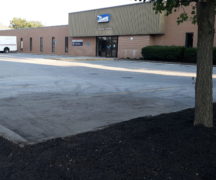By JAN McLAUGHLIN
BG Independent News
As the new year rolled over, Bowling Green Mayor Mike Aspacher checked some items off the city’s “to do” list.
Moved into new city building. Check. Dispersed COVID relief funds. Check. Attracted new business and housing investments. Check. Completed zoning code updates. Check.
But as Aspacher has learned over the years, most of the items on the city’s list take several years to accomplish.
“Many of the things we as elected officials set as strategic goals are big and take time,” he said, sitting in his new office overlooking North Main Street in the downtown. “There’s a lot of carryover.”
So when the city can check off a strategic planning objective, it’s a big deal.
“We accomplished a lot as a community,” Aspacher said, topping the list with the completion of a new city building after decades of planning. “That was a big accomplishment for us.”
Ride wave of new high school
The biggest game changer for the city was the passage of a bond issue for a new Bowling Green High School. Though that wasn’t the city’s responsibility, the mayor and city council publicly endorsed the issue.
Aspacher praised the community for doing the right thing.
“We all know the history of what it took to pass that,” he said, predicting growth of the community because of the “new state-of-the-art” high school.
“We should celebrate that. It will positively impact the education of our young people,” he said, plus attract and retain teachers, bring in new businesses or convince existing ones to expand here, and attract investments in new housing.
Attracting growth
Three new housing developments are in the works, including 130 homes at Brim and Newton roads, 21 homes in another plat at Stone Ridge, and 96 apartments off South Main Street.
And the mayor said the city’s economic development director, Kati Thompson, is seeing interest in all types of businesses wanting to invest in Bowling Green.
“She’s fielding a lot of calls in multiple sectors,” Aspacher said of Thompson. “We’re optimistic about continued growth.”
Funneling ARPA funds
The $7 million in American Rescue Plan Act funds has allowed the city to spend money in areas that would have otherwise gone unfunded. And it will continue during 2024.
“That has had a profound impact on infrastructure in town,” the mayor said. “We’re going to keep paving streets.”
And it has been used to help homeowners who were unable to fix their roofs, update their furnaces, or other necessities.
“That has resulted in real improvements in people’s lives, plus had positive effects in neighborhoods,” Aspacher said.
City officials are watching the clock as it ticks down to the end of 2026, when the funding must be spent or returned.
“We will not be giving any ARPA funds back,” Aspacher said.
What lies ahead for fire and police stations
While checking off some items on the city’s to-do list, two biggies loom in the not too distant future.
The mayor believes it’s time to come up with a plan to improve the city’s fire and police stations – and devise a plan to fund those capital projects.
“It’s really important to me that we begin to plan to address police and fire facilities,” he said.
The east side fire station, on East Court Street, is “structurally unsound,” the mayor said. The city has been working with a statewide fire chiefs association to determine where the replacement station should be located, and if the city needs more than its current two stations.
“We’re always mindful of response times,” Aspacher said.
As for the police station, it’s not moving. But it needs to expand, the mayor said.
“We will utilize the existing site. It’s really important we maintain a presence in the downtown,” he said.
The core responsibility of city government is to provide vital services, like police, fire and public utilities. From there, the city must address “quality of life” services, such as city parks and public works.
“It’s so important we recognize how these contribute to the quality of life,” Aspacher said.





